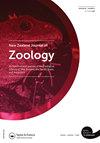环境和人为干扰对圈养猕猴桃(Apteryx mantelli)行为的影响
IF 1.1
4区 生物学
Q3 ZOOLOGY
引用次数: 1
摘要
研究了15只圈养褐几维鸟(Apteryx mantelli)的行为,以及干扰对其行为的影响。它们都被放在夜间展示的设施里,在新西兰被称为几维之家,在这里被称为围栏1-4。我们的详细研究首先对圈养几维鸟的正常行为进行了基线评估,以此来定义异常行为。我们发现异常行为(步调和惊吓反应)通常是由三种不同的干扰来源之一引起的:游客通过玻璃窗户观看几维鸟时产生的噪音,大雨引起的噪音,以及饲养员的互动。由于噪音是干扰的主要因素,我们量化了每个圈地内到达几维鸟展示空间内部的声音体积,并将其与几维鸟的行为联系起来。我们的研究结果表明,圈养几维鸟的异常行为可以通过消除或减少干扰来最小化,我们建议如何在未来通过减少噪音干扰来改善围栏的设计和结构,(1)通过安装双层或三层玻璃窗细木工来减少来自游客的噪音干扰,(2)通过在屋顶和墙壁上增加绝缘来减少来自外部的噪音干扰。文章历史接收2020年7月1日接收2021年3月15日首次在线发布2021年4月21日处理编辑詹姆斯·布里斯基本文章由计算机程序翻译,如有差异,请以英文原文为准。
Impacts of environmental and human disturbances on behaviour of captive kiwi (Apteryx mantelli)
We studied the behaviour of 15 captive brown kiwi (Apteryx mantelli), and the effects of disturbance on their behaviour. They were all held in nocturnal display facilities, known in New Zealand as Kiwi Houses and referred to here as enclosures 1–4. Our detailed study first compiled a baseline assessment of normal behaviours of captive kiwi from which to define the abnormal. We found that abnormal behaviours (pacing and startle responses) were usually stimulated by one of three different sources of disturbance: noise generated by visitors viewing the kiwi through glass-viewing windows, noise resulting from heavy rainfall, and keeper interactions. As noise was a major contribution to disturbance, we quantified the volume of sound that reached the interior of the kiwi display spaces within each enclosure, and correlated it with kiwi behaviour. Our results show how abnormal behaviours among captive kiwi can be minimised by eliminating or reducing disturbances, and we suggest how the design and structure of the enclosures can be improved in the future by mitigating noise disturbance, (1) from visitors by installation of double or triple glazed window joinery, and (2) from outside by greater insulation in the roof and walls. ARTICLE HISTORY Received 1 July 2020 Accepted 15 March 2021 First Published Online 21 April 2021 HANDLING EDITOR James Briskie
求助全文
通过发布文献求助,成功后即可免费获取论文全文。
去求助
来源期刊
CiteScore
2.80
自引率
0.00%
发文量
20
审稿时长
>12 weeks
期刊介绍:
Aims: The diversity of the fauna of the southern continents and oceans is of worldwide interest to researchers in universities, museums, and other centres. The New Zealand Journal of Zoology plays an important role in disseminating information on field-based, experimental, and theoretical research on the zoology of the region.

 求助内容:
求助内容: 应助结果提醒方式:
应助结果提醒方式:


